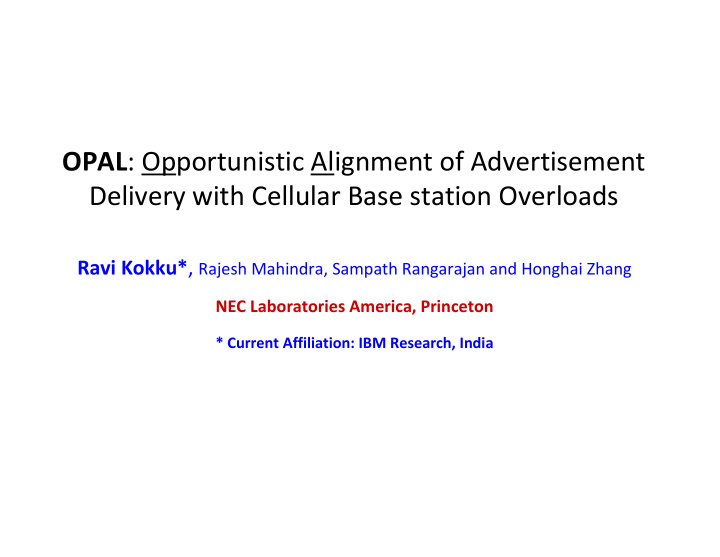



OPAL : Opportunistic Alignment of Advertisement Delivery with Cellular Base station Overloads Ravi Kokku* , Rajesh Mahindra, Sampath Rangarajan and Honghai Zhang NEC Laboratories America, Princeton * Current Affiliation: IBM Research, India
Motivation: 3 Observations 1. Mobile video traffic increasing significantly • 66% Mobile content will be video by 2015 [Cisco] [ChinaMobile] 2. Base station Overloads a growing concern • Users QoE suffers, especially for video • Not always overloaded: so worst-case provisioning expensive 3. Operator-enabled Mobile Advertising attractive revenue generator • Users get interrupted every so often OPAL aligns overloads with advertisements to minimize user interruption 2
What this paper “is”, and “is not” • This paper is not about advertising! • Instead, it is the following: – Operator-enabled advertising will happen anyway – Basestation overloads are also happening anyway – How can we align them to improve the overall user perception of the cellular network? 3
Outline • Merits – Why align advertisement delivery with base station overloads? • Opal Design Overview – How to do Overload Management to make it suit ad delivery? – How to do ad delivery? • Evaluation – Prototype on a WiMAX testbed – Simulation with larger scale scenarios • Conclusion – Future work 4
Impact of Base station Overload • Base station overloads lead to reduced bandwidth per user – HTTP videos � number of stalls and time of stalls are important metrics [sigcomm11] • Tradeoff with client buffer size • More dramatic increase in num.stalls than stall time 5
Can we do something using Ads? • Advertisement delivery is in control of MNO – Choice of advertisements (banners to videos) – Rate of advertisements • So, instead of letting every user suffer – show an advertisement of lower rate to some users • Benefits both users and MNOs – Users: Notion of continuity of service, reduced pricing (ad-funded network service) – MNOs: Mask off the effect of overload, users happier than perceiving bad availability 6
Opal Design Gateway-level solution • When to migrate? – Uses Svc rate and queue buildup – Challenge: BS capacity unknown – Solution: Synchronizer • Which users to migrate? – Uses a long term fairness metric • When to bring the users back? 7
Tunable Unavailability Framework – V t configurable by the network operators • Controllable � predictable ad delivery – Mobile Marketing Association suggests 15 to 30 seconds • www.mmaglobal.com • ~700 member companies 8
Advertisement Delivery 1. Show ads more aggressively during overloads 2. Balance the total shows over a longer time period 3. Current design: No state maintenance – The design changes slightly for targeted advertising • Main challenge: Smooth inter-mixing of content and advertisements – Either intermediate proxy or – a notion of an ad channel that client side applications understand • Need standardization! 9
Prototype on a WiMAX Platform Clients ASN Gateway CSN Gateway Basestation Antenna Attenuator • Opal on ASN gateway • Ad server attached to ASN gateway • Client modified to play ad during buffer under-run • Feedback from BS every 100ms 10
Expt 1: QoE Improvement Prototype setup: YouTube videos are streamed to six clients. OPAL NO-OPAL 1.Serving Ads to a few users ensures maximum users see good quality. 2.OPAL efficiently uses advertisements to hide service disruption. 11
Expt 2: Simulation Study Set-up: In-house System-level OFDMA simulator with representative traffic models and channel models. Videos are streamed to 30,32 and 34 users REGULAR TARGET Num. users Num. users OPAL finds the appropriate no. of users in the regular slice 12
Conclusion • OPAL: Align advertisement delivery with cellular basestation overloads – Improves overall user perception of network availability • Operator Enabled Advertising: Lot of Scope for Future Work – Incorporate different classes of users – Targeted and location-based advertising – Muticast for advertisements, or local playout on user devices – Quantify user perception of overloads and Advertisement delivery – … 13
Backup 14
Network Operators’ Challenge China Mobile http://labs.chinamobile.com/article_download.php?id=63069 Telefonica: http://research.microsoft.com/en-us/events/cnb2010/pablorodriguez.pdf Sprint: http://www.slideshare.net/trxrse/traffic-revenues-decoupling-3584286 � Increasing Cost to support ever growing traffic • Traffic increasing by 90% every year • Network throughput increasing by 55% � Reducing Revenue per byte due to data traffic 15
Recommend
More recommend